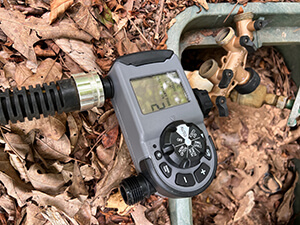
A properly set timer for the irrigation system can lead to better plant and grass health.
Hot, hot, hot and there never seems to be enough rain. When you’re growing vegetables, fruit, flowering shrubs and lawns, to be efficient and effective, you need a system.
Lawn irrigation works well for established turfgrass, as long as you’re watering properly. Water deeply – at least one inch – one time a week and that will help protect your lawn and landscape investment.
Test the output of your irrigation by placing three to five low cat food or tuna cans in the zone. Then run that zone for one cycle and measure what’s made it into the cans. If you don’t get an inch, lengthen the cycle; if you’re overflowing, shorten it.
Warm-season grasses, like Bermuda, zoysia and centipede, need deep watering to encourage the roots to grow farther into the soil. When you water more often with less volume, you’re encouraging the roots to grow shorter; this encourages diseases and is hard on the grass.
Adjust your mowing height as well, raising your mower for zoysia half an inch in the summer heat. Bermuda can be cut to a height of one to two inches. Never remove more than one-third of the blades’ height at a time.
Plants, trees and shrubs
Pay attention to the foundations of your landscape, such as trees, shrubs and perennials. If you think it’s too hot to walk around your yard, imagine what your plants are enduring.
However, a walk will reveal issues before they become serious. Leaves of shrubs and trees should be green and healthy looking. If they’re grayish, dull or wilted, it’s past time to water. Water deeply every several days, using either your irrigation system if it covers the area, or drip irrigation.
The best trick I’ve learned is to have garden hoses and sprinklers strategically placed around the yard. When we installed our irrigation, we added five or six separate faucets away from the house that now are fitted with faucet splitters and multiple hoses. We also purchased timers to automate the process.
Zones are set for 75-90 minutes in our vegetable and rose gardens, watering about every three days. When everything’s working right, the yard and landscape look like springtime without any heat stress.
We water in the morning for a couple of reasons: there’s less evaporation so more water gets to the plants; it’s cooler and decreases the risk of damaging the leaves during the midday sun; and morning watering allows plenty of time for the leaves to dry, reducing the chance of diseases and fungus.
During the heat of July, the watering systems kept us in fresh tomatoes, squash, green beans, peppers and okra. We shared with friends and neighbors.
Mulch is your friend
To enhance the effectiveness of watering, apply 2-4 inches of mulch around your shrubs and trees, being careful to leave six inches of space between trunks or branches and the layer of mulch.
Do the same with your annuals, perennials and vegetables. A two-inch layer will hold in moisture and reduce the need to weed. I even use a couple of layers of newspaper beneath the mulch to further keep weeds at bay.
Here’s another trick: Water first, pull any larger weeds, then mulch. By watering first, you’re loosening the soil to make the weeds easier to pull. You’re also getting water to the plant’s roots directly. Covering the wet soil will hold in moisture and also keep the roots cooler.
There’s no denying that summer heat is great for heading to the lake. To give you more lake time and less demand from your landscape, try these methods to keep your lawn and gardens healthy.
Photo: by Pamela A. Keene





